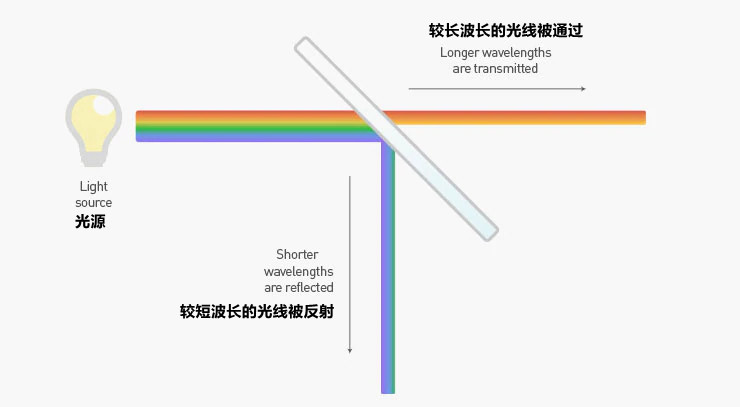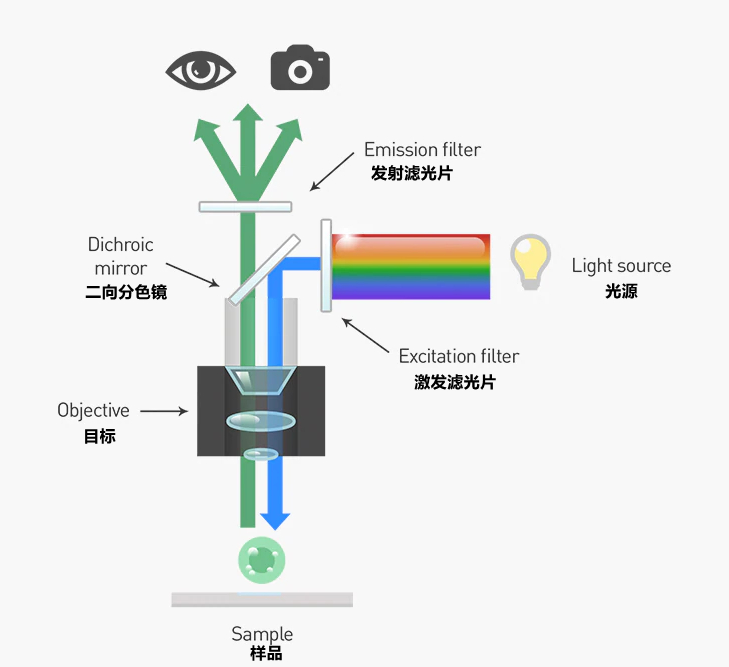Fluorescence microscope is a kind of optical microscope, generally the object to be observed is transparent, or the internal structure can not be well differentiated from the color, then the fluorescence microscope is a good choice to solve the ordinary microscope can not observe the problem of transparent substances. The principle of fluorescence microscope is to use short wavelength light to irradiate the examined object stained with fluorescein, so that it will be excited and produce long wavelength fluorescence, thus allowing the observer to observe the internal structure of the sample. In a fluorescence microscope, a specific wavelength of excitation light must be selected for the illumination of the specimen to produce fluorescence, and then the fluorescence must be separated from the mixed excitation and fluorescence light for observation. Therefore, the filter system plays an extremely important role in selecting a specific wavelength. Fluorescence microscopes are widely used in biological and medical fields.
A fluorescence microscope includes the following basic components:
a. Light source: usually xenon arc lamps or mercury lamps, but in recent years high-power LEDs have also been used.
b. Filter (incident light): reduces the wavelength of the incident light to a wavelength that leaves only the wavelength used to excite the sample, which is interestingly called an excitation filter.
c. Dichroic Mirror or Reflector: Reflects the excitation light onto the sample and simultaneously passes only the emitted light from the sample to the detector (as shown in the figure below).
d. Filter (Emission): Only the wavelength of the emission light from the sample can be passed and all light passing through the excitation filter is blocked, as you would expect, it is called an emission filter.
e. CCD camera: Emitted light is of no use if it cannot be detected; for fluorescence imaging, the detector is usually a CCD camera, which is also usually connected to a computer screen that can present you with an image.

Dichroic mirrors allow longer wavelengths of light to pass through the filter while reflecting shorter wavelengths of light
Fluorescence microscopy classification:
Fluorescence microscopes are generally categorized into two types: transmission and falling-beam:
a. Transmissive: the excitation light comes from the bottom of the examined object, and the spotting lens is a dark-field spotting lens, so that the excitation light does not enter the objective lens, but the fluorescence enters the objective lens. It is bright at low magnification, while the high magnification is dark, in the oil immersion and tuning, it is more difficult to operate, especially at low magnification of the illumination range is difficult to determine, but can get a very dark field of view of the background. The transmission type is not used for non-transparent examined objects.
b. Falling type: Transmission type is almost eliminated at present, the new fluorescence microscope is mostly falling type, the light source is from the top of the examined object, and there is a beam splitter in the optical path, so it is suitable for both transparent and opaque examined objects. As the objective lens plays the role of a spotting mirror, it is not only easy to operate, but also from low magnification to high magnification, it can realize the uniform illumination of the whole field of view.

Typical optical path of a falling light fluorescence microscope
